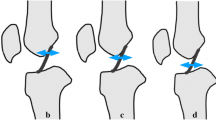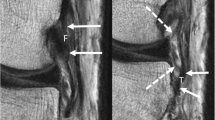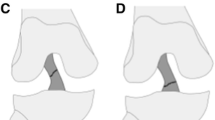Abstract
Objective
To evaluate previously described primary and secondary MRI signs of disruption to anterior cruciate ligament (ACL) grafts in surgically proven cases.
Materials and methods
We retrospectively analyzed MR images of 48 patients (mean age 29 years) with clinically suspected ACL graft disruption. All patients had surgical confirmation of the MRI findings. The reviewers analyzed the cases blinded to the surgical results and assessed each of the primary and secondary MRI signs of graft disruption individually. Subsequently, a final impression of the graft integrity based on a comprehensive assessment of all of the primary and secondary findings was made.
Results
Utilizing a comprehensive assessment of previously described primary and secondary MR findings of ACL graft disruption, the blinded reviewers were able to identify correctly full-thickness graft tears with test accuracy of 85%, sensitivity of 72%, and specificity of 100%. Individual assessment of the primary finding of graft fiber discontinuity had sensitivity, specificity, positive predictive value, negative predictive value, and accuracy of 72%, 100%, 100%, 77% and 85%, respectively, for full-thickness tears. Other individual primary and secondary findings were less reliable; however, the primary findings of marked segmental thinning of the graft and markedly abnormal graft orientation, and the secondary findings of bone contusions in the lateral compartment and large joint effusion, had high specificity and positive predictive value. Of the four missed cases, two had associated arthrofibrosis.
Conclusion
The comprehensive assessment of previously described primary and secondary MRI findings of ACL graft disruption has high test specificity and moderately high test accuracy. The presence of graft fiber discontinuity is the most reliable primary or secondary finding when assessed individually. Marked segmental thinning of the graft and abnormal fiber orientation, and the presence of bone contusions in the lateral compartment and large joint effusion, are less reliable overall but are highly suggestive of full-thickness graft tear when present.





Similar content being viewed by others
References
Canale ST. Campbell’s operative orthopedics, 10 ed. St. Louis: Mosby, 2003.
White LM, Kramer J, Recht MP. MR imaging evaluation of the postoperative knee: ligaments, menisci, and articular cartilage. Skeletal Radiol 2005; 34: 431–452.
Irizarry JM, Recht MP. MR imaging of the knee ligaments and the postoperative knee. Radiol Clin North Am 1997; 35: 45–76.
Horton LK, Jacobson JA, Lin J, Hayes CW. MR imaging of anterior cruciate ligament reconstruction graft. AJR Am J Roentgenol 2000; 175: 1091–1097.
Nakayama Y, Shirai Y, Narita T, Mori A, Kobayashi K. The accuracy of MRI in assessing graft integrity after anterior cruciate ligament reconstruction. J Nippon Med Sch 2001; 68: 45–49.
Rak KM, Gillogly SD, Schaefer RA, Yakes WF, Liljedahl RR. Anterior cruciate ligament reconstruction: evaluation with MR imaging. Radiology 1991; 178: 553–556.
Schatz JA, Potter HG, Rodeo SA, Hannafin JA, Wickiewicz TL. MR imaging of anterior cruciate ligament reconstruction. AJR Am J Roentgenol 1997; 169: 223–228.
Tung GA, Davis LM, Wiggins ME, Fadale PD. Tears of the anterior cruciate ligament: primary and secondary signs at MR imaging. (see comment). Radiology 1993; 188: 661–667.
Echigo J, Yoshioka H, Takahashi H, Niitsu M, Fukubayashi T, Itai Y. Signal intensity changes in anterior cruciate ligament autografts: relation to magnetic field orientation. Acad Radiol 1999; 6: 206–210.
Howell SM, Berns GS, Farley TE. Unimpinged and impinged anterior cruciate ligament grafts: MR signal intensity measurements. Radiology 1991; 179: 639–643.
Howell SM, Clark JA, Blasier RD. Serial magnetic resonance imaging of hamstring anterior cruciate ligament autografts during the first year of implantation. A preliminary study. Am J Sports Med 1991; 19: 42–47.
Papakonstantinou O, Chung CB, Chanchairujira K, Resnick DL. Complications of anterior cruciate ligament reconstruction: MR imaging. Eur Radiol 2003; 13: 1106–1117.
LaPrade RF, Burnett QM 2nd, Veenstra MA, Hodgman CG. The prevalence of abnormal magnetic resonance imaging findings in asymptomatic knees. With correlation of magnetic resonance imaging to arthroscopic findings in symptomatic knees. Am J Sports Med 1994; 22: 739–745.
Murao H, Morishita S, Nakajima M, Abe M. Magnetic resonance imaging of anterior cruciate ligament (ACL) tears: diagnostic value of ACL-tibial plateau angle. J Orthop Sci 1998; 3: 10–17.
Ha TP, Li KC, Beaulieu CF, et al. Anterior cruciate ligament injury: fast spin-echo MR imaging with arthroscopic correlation in 217 examinations. AJR Am J Roentgenol 1998; 170: 1215–1219.
Murakami Y, Sumen Y, Ochi M, Fujimoto E, Adachi N, Ikuta Y. MR evaluation of human anterior cruciate ligament autograft on oblique axial imaging. J Comput Assist Tomogr 1998; 22: 270–275.
Yamato M, Yamagishi T. MRI of patellar tendon anterior cruciate ligament autografts. J Comput Assist Tomogr 1992; 16: 604–607.
McCauley TR, Elfar A, Moore A, et al. MR arthrography of anterior cruciate ligament reconstruction grafts. AJR Am J Roentgenol 2003; 181: 1217–1223.
Magee T, Shapiro M, Rodriguez J, Williams D. MR arthrography of postoperative knee: for which patients is it useful? Radiology 2003; 229: 159–163.
Acknowledgments
The authors would like to thank Linda Greene for her assistance with manuscript preparation.
Author information
Authors and Affiliations
Corresponding author
Rights and permissions
About this article
Cite this article
Collins, M.S., Unruh, K.P., Bond, J.R. et al. Magnetic resonance imaging of surgically confirmed anterior cruciate ligament graft disruption. Skeletal Radiol 37, 233–243 (2008). https://doi.org/10.1007/s00256-007-0423-2
Received:
Revised:
Accepted:
Published:
Issue Date:
DOI: https://doi.org/10.1007/s00256-007-0423-2




